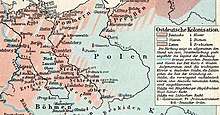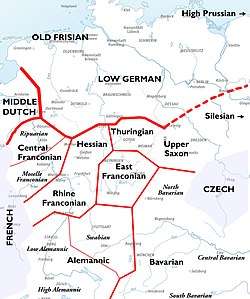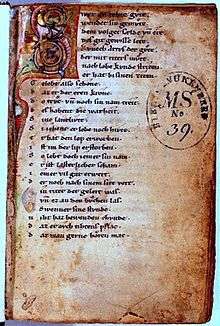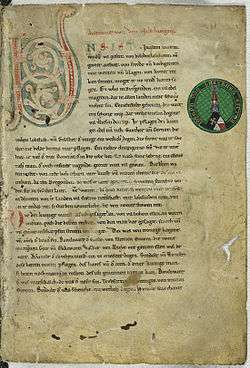Middle High German
Middle High German (abbreviated MHG, German: Mittelhochdeutsch, abbr. Mhd.) is the term for the form of German spoken in the High Middle Ages. It is conventionally dated between 1050 and 1350, developing from Old High German and into Early New High German. High German is defined as those varieties of German which were affected by the Second Sound Shift; the Middle Low German and Middle Dutch languages spoken to the North and North West, which did not participate in this sound change, are not part of MHG.
| Middle High German | |
|---|---|
| diutsch, tiutsch | |
| Region | Central and southern Germany, Austria and parts of Switzerland |
| Era | High Middle Ages |
Indo-European
| |
Early form | |
| Language codes | |
| ISO 639-2 | gmh (ca. 1050-1500) |
| ISO 639-3 | gmh (ca. 1050-1500) |
| ISO 639-6 | mdgr |
| Glottolog | midd1343[1] |
While there is no standard MHG, the prestige of the Hohenstaufen court gave rise in the late 12th century to a supra-regional literary language (mittelhochdeutsche Dichtersprache) based on Swabian, an Alemannic dialect. This historical interpretation is complicated by the tendency of modern editions of MHG texts to use normalised spellings based on this variety (usually called "Classical MHG"), which make the written language appear more consistent than is actually the case in the manuscripts. Scholars are uncertain as to whether the literary language reflected a supra-regional spoken language of the courts.
An important development in this period was the Ostsiedlung, the eastward expansion of German settlement beyond the Elbe-Saale line which marked the limit of Old High German. This process started in the 11th century, and all the East Central German dialects are a result of this expansion.
"Judeo-German", the precursor of the Yiddish language, sees attestation in the 12th–13th centuries, as a variety of Middle High German written in Hebrew characters.
Periodisation


The Middle High German period is generally dated from 1050 to 1350.[2][3][4][5] An older view puts the boundary with (Early) New High German around 1500.[5] [6]
There are several phonological criteria which separate MHG from the preceding Old High German period:[7]
- the weakening of unstressed vowels to ⟨e⟩: OHG taga, MHG tage ("days")[8]
- the full development of Umlaut and its use to mark a number of morphological categories[8]
- the devoicing of final stops: OHG tag > MHG tac ("day")[9][10]
Culturally, the two periods are distinguished by the transition from a predominantly clerical written culture, in which the dominant language was Latin, to one centred on the courts of the great nobles, with German gradually expanding its range of use.[3][11] The rise of the Hohenstaufen dynasty in Swabia makes the South West the dominant region in both political and cultural terms.[12]
Demographically, the MHG period is characterised by a massive rise in population,[13] terminated by the demographic catastrophe of the Black Death (1348).[14] Along with the rise in population comes a territorial expansion eastwards (Ostsiedlung), which saw German-speaking settlers colonise land previously under Slavic control.[15][16]
Linguistically, the transition to Early New High German is marked by four vowel changes which together produce the phonemic system of modern German, though not all dialects participated equally in these changes:[17]
- Diphthongisation of the long high vowels /iː yː uː/ > /aɪ̯ ɔʏ̯ aʊ̯/: MHG hût > NHG Haut ("skin")
- Monophthongisation of the high centering diphthongs /iə yə uə/ > /iː yː uː/: MHG huot > NHG Hut ("hat")
- lengthening of stressed short vowels in open syllables: MHG sagen /zaɡən/ > NHG sagen /zaːɡən/ ("say")
- The loss of unstressed vowels in many circumstances: MHG vrouwe > NHG Frau ("lady")
The centres of culture in the ENHG period are no longer the courts but the towns.[18]
Dialects

The dialect map of Germany by the end of the Middle High German period was much the same as that at the start of the 20th century, though the boundary with Low German was further south than it now is:[19][20]
Central German (Mitteldeutsch)[21]
- West Central German (Westmitteldeutsch)
- East Central German (Ostmitteldeutsch)
- Thuringian (Thüringisch)
- Upper Saxon (Obersächsisch)
- Silesian (Schlesisch)
- High Prussian (Hochpreußisch)
Upper German (Oberdeutsch)[22]
- East Franconian (Ostfränkisch)
- South Rhine Franconian (Südrheinfränkisch)
- Alemannic (Alemannisch)
- North Alemannic/Swabian (Niederalemannisch/Schwäbisch)
- Low Alemannic (Niederalemannisch)
- High Alemannic/South Alemannic (Hochalemannisch/Südalemannisch) )
- Bavarian (Bayrisch)
- Northern Bavarian (Nordbayrisch)
- Central Bavarian (Mittelbayrisch)
- Southern Bavarian (Südbayrisch)
With the exception of Thuringian, the East Central German dialects are new dialects resulting from the Ostkolonisation and arise towards the end of the period.[19][23]
Writing system
Middle High German texts are written in the Latin alphabet. There was no standardised spelling, but modern editions generally standardise according to a set of conventions established by Karl Lachmann in the 19th century.[24] There are several important features in this standardised orthography which are not characteristics of the original manuscripts:
- the marking of vowel length is almost entirely absent from MHG manuscripts.[25]
- the marking of umlauted vowels is often absent or inconsistent in the manuscripts.[26]
- a curly-tailed z (⟨ȥ⟩ or ⟨ʒ⟩) is used in modern handbooks and grammars to indicate the /s/ or /s/-like sound which arose from Germanic /t/ in the High German consonant shift. This character has no counterpart in the original manuscripts, which typically use ⟨s⟩ or ⟨z⟩ to indicate this sound.[27]
- the original texts often use ⟨i⟩ and ⟨uu⟩ for the semi-vowels /j/ and /w/.[28]
A particular problem is that many manuscripts are of much later date than the works they contain; as a result, they bear the signs of later scribes having modified the spellings, with greater or lesser consistency, in accord with conventions of their time.[29] In addition, there is considerable regional variation in the spellings that appear in the original texts, which modern editions largely conceal.[30]
Vowels
The standardised orthography of MHG editions uses the following vowel spellings:[25]
- Short vowels: ⟨a e i o u⟩ and the umlauted vowels ⟨ä ö ü⟩
- Long vowels: ⟨â ê î ô û⟩ and the umlauted vowels ⟨æ œ iu⟩
- Diphthongs: ⟨ei ou ie uo⟩; and the umlauted diphthongs ⟨öu eu oi üe⟩
Grammars (as opposed to textual editions) often distinguish between ⟨ë⟩ and ⟨e⟩, the former indicating the mid-open /ɛ/ which derived from Germanic /e/, the latter (often with a dot beneath it) indicating the mid-close /e/ which results from primary umlaut of short /a/. No such orthographic distinction is made in MHG manuscripts.[25]
Consonants
The standardised orthography of MHG editions uses the following consonant spellings:[27]
- Stops: ⟨p t k/c/q b d g⟩
- Affricates: ⟨pf/ph tz/z⟩
- Fricatives: ⟨v f s ȥ sch ch h⟩
- Nasals: ⟨m n⟩
- Liquids: ⟨l r⟩
- Semivowels: ⟨w j⟩
Phonology
The charts show the vowel and consonant systems of classical MHG. The spellings indicated are the standard spellings used in modern editions – there is much more variation in the manuscripts.
Vowels
Short and long Vowels
| front | central | back | ||||||
|---|---|---|---|---|---|---|---|---|
| unrounded | rounded | |||||||
| short | long | short | long | short | long | short | long | |
| close | i | iː | y ⟨ü⟩ | yː ⟨iu⟩ | u | uː | ||
| close-mid | e | |||||||
| mid | ɛ | ɛː | ø ⟨ö⟩ | øː ⟨œ⟩ | o | oː | ||
| open-mid | æ ⟨ä⟩ | æː ⟨æ⟩ | ||||||
| open | a | aː | ||||||
Notes:
- Not all dialects distinguish the three unrounded mid front vowels.
- It is probable that the short high and mid vowels are lower than their long equivalents, as in Modern German, but this is impossible to establish from the written sources.
- The ⟨e⟩ found in unstressed syllables may indicate [ɛ] or schwa [ə].
Diphthongs
MHG diphthongs are indicated by the spellings: ⟨ei⟩, ⟨ie⟩, ⟨ou⟩, ⟨öu⟩ and ⟨eu⟩, ⟨üe⟩, ⟨uo⟩, having the approximate values of /ei/, /iə/, /ou/, /øy/, /eu/, /yə/, and /uə/, respectively.
Consonants
| Bilabial | Labiodental | Alveolar | Postalveolar | Palatal | Velar | Glottal | |
|---|---|---|---|---|---|---|---|
| Plosive | p b | t d | k ⟨k, c⟩ ɡ | ||||
| Affricates | p͡f | t͡s ⟨z⟩ | |||||
| Nasal | m | n | ŋ ⟨ng⟩ | ||||
| Fricative | f v ⟨f, v⟩ | s z ⟨ȥ⟩ ⟨s⟩ | ʃ ⟨sch⟩ | x ⟨ch, h⟩ | h | ||
| Approximant | w | j | |||||
| Liquid | r l |
- Precise information about the articulation of consonants is impossible to establish, and will have varied between dialects.
- In the plosive and fricative series, where there are two consonants in a cell, the first is fortis the second lenis. The voicing of lenis consonants varied between dialects.
- MHG has long consonants, and the following double consonant spellings indicate not vowel length as in Modern German orthography, but rather genuine double consonants: pp, bb, tt, dd, ck (for /kk/), gg, ff, ss, zz, mm, nn, ll, rr.
- It is reasonable to assume that /x/ had an allophone [χ] after back vowels, as in Modern German.
Grammar
Pronouns
Middle High German pronouns of the first person refer to the speaker; those of the second person refer to an addressed person; and those of the third person refer to person or thing of which one speaks. The pronouns of the third person may be used to replace nominal phrases. These have the same genders, numbers and cases as the original nominal phrase.
Personal pronouns
| 1st sg | 2nd sg | 3rd sg | 1st pl | 2nd pl | 3rd pl | |||
|---|---|---|---|---|---|---|---|---|
| Nominative | ich | du | ër | sie | ëz | wir | ir | sie |
| Accusative | mich | dich | in | sie | ëz | uns | iuch | sie |
| Dative | mir | dir | im | ir | im | uns | iu | in |
| Genitive | mîn | dîn | sîn | ir | sîn | unser | iuwer | ir |
Possessive pronouns
The possessive pronouns mîn, dîn, sîn, ir, unser, iuwer are used like adjectives and hence take on adjective endings following the normal rules.
Articles
The inflected forms of the article depend on the number, the case and the gender of the corresponding noun. The definite article has the same plural forms for all three genders.
Definite article (strong)
| Case | Masculine | Neuter | Feminine | Plural |
|---|---|---|---|---|
| Nominative | dër | daȥ | diu | die / diu |
| Accusative | dën | daȥ | die | die / diu |
| Dative | dëm | dër | dën | |
| Genitive | dës | dër | dër | |
| Instrumental | diu | |||
The instrumental case, only existing in the neuter singular, is used only with prepositions: von diu, ze diu, etc. In all the other genders and in the plural it is substituted with the dative: von dëm, von dër, von dën.
Nouns
Middle High German nouns were declined according to four cases (nominative, genitive, dative, accusative), two numbers (singular and plural) and three genders (masculine, feminine and neuter), much like Modern High German, though there are several important differences.
Strong nouns
| dër tac day m. |
diu zît time f. |
daȥ wort word n. | ||||
|---|---|---|---|---|---|---|
| Singular | Plural | Singular | Plural | Singular | Plural | |
| Nominative | dër tac | die tage | diu zît | die zîte | daȥ wort | diu wort |
| Genitive | dës tages | dër tage | dër zît | dër zîte | dës wortes | dër worte |
| Dative | dëm tage | dën tagen | dër zît | dën zîten | dëm worte | dën worten |
| Accusative | dën tac | die tage | die zît | die zîte | daȥ wort | diu wort |
Weak nouns
| dër veter (male) cousin m. |
diu zunge tongue f. |
daȥ herze heart n. | ||||
|---|---|---|---|---|---|---|
| Singular | Plural | Singular | Plural | Singular | Plural | |
| Nominative | dër veter | die veteren | diu zunge | die zungen | daȥ herze | diu herzen |
| Genitive | dës veteren | dër veteren | dër zungen | dër zungen | dës herzen | dër herzen |
| Dative | dëm veteren | dën veteren | dër zungen | dën zungen | dëm herzen | dën herzen |
| Accusative | dën veteren | die veteren | die zungen | die zungen | daȥ herze | diu herzen |
Verbs
Verbs were conjugated according to three moods (indicative, subjunctive (conjunctive) and imperative), three persons, two numbers (singular and plural) and two tenses (present tense and preterite) There was a present participle, a past participle and a verbal noun that somewhat resembles the Latin gerund, but that only existed in the genitive and dative cases.
An important distinction is made between strong verbs (that exhibited ablaut) and weak verbs (that didn't).
Furthermore, there were also some irregular verbs.
Strong verbs
The present tense conjugation went as follows:
| nëmen to take | ||
|---|---|---|
| Indicative | Subjunctive | |
| 1. sg. | ich nime | ich nëme |
| 2. sg. | du nim(e)st | du nëmest |
| 3. sg. | ër nim(e)t | er nëme |
| 1. pl. | wir nëmen | wir nëmen |
| 2. pl. | ir nëm(e)t | ir nëmet |
| 3. pl. | sie nëment | sie nëmen |
- Imperative: 2.sg.: nim, 2.pl.: nëmet
- Present participle: nëmende
- Infinitive: nëmen
- Verbal noun: genitive: nëmen(n)es, dative: ze nëmen(n)e
The bold vowels demonstrate umlaut; the vowels in brackets were dropped in rapid speech.
The preterite conjugation went as follows:
| genomen haben to have taken | ||
|---|---|---|
| Indicative | Subjunctive | |
| 1. sg. | ich nam | ich næme |
| 2. sg. | du næme | du næmest |
| 3. sg. | ër nam | er næme |
| 1. pl. | wir nâmen | wir næmen |
| 2. pl. | ir nâmet | ir næmet |
| 3. pl. | sie nâmen | sie næmen |
- Past participle: genomen
Weak verbs
The present tense conjugation went as follows:
| suochen to seek | ||
|---|---|---|
| Indicative | Subjunctive | |
| 1. sg. | ich suoche | ich suoche |
| 2. sg. | du suoch(e)st | du suochest |
| 3. sg. | ër suoch(e)t | er suoche |
| 1. pl. | wir suochen | wir suochen |
| 2. pl. | ir suoch(e)t | ir suochet |
| 3. pl. | sie suochent | sie suochen |
- Imperative: 2.sg: suoche, 2.pl: suochet
- Present participle: suochende
- Infinitive: suochen
- Verbal noun: genitive: suochennes, dative: ze suochenne
The vowels in brackets were dropped in rapid speech.
The preterite conjugation went as follows:
| gesuocht haben to have sought | ||
|---|---|---|
| Indicative | Subjunctive | |
| 1. sg. | ich suochete | ich suochete |
| 2. sg. | du suochetest | du suochetest |
| 3. sg. | ër suochete | er suochete |
| 1. pl. | wir suocheten | wir suocheten |
| 2. pl. | ir suochetet | ir suochetet |
| 3. pl. | sie suochetent | sie suocheten |
- Past participle: gesuochet
Vocabulary
Sample texts
Iwein

The text is the opening of Hartmann von Aue's Iwein (c. 1200)
| Middle High German[31] | English translation | |
|---|---|---|
Swer an rehte güete |
[1] |
Whoever to true goodness |
Commentary: This text shows many typical features of Middle High German poetic language. Most Middle High German words survive into modern German in some form or other: this passage contains only one word (jehen 'say' 14) which has since disappeared from the language. But many words have changed their meaning substantially. Muot (6) means 'state of mind' (cognates with mood), where modern German Mut means courage. Êre (3) can be translated with 'honour', but is quite a different concept of honour from modern German Ehre; the medieval term focusses on reputation and the respect accorded to status in society.[32]
Nibelungenlied

The text is the opening strophe of the Nibelungenlied (c. 1204).
Middle High German[33]
Uns ist in alten mæren wunders vil geseit
von helden lobebæren, von grôzer arebeit,
von freuden, hôchgezîten, von weinen und von klagen,
von küener recken strîten muget ir nu wunder hœren sagen.Modern German translation[34]
In alten Erzählungen wird uns viel Wunderbares berichtet
von ruhmreichen Helden, von hartem Streit,
von glücklichen Tagen und Festen, von Schmerz und Klage:
vom Kampf tapferer Recken: Davon könnt auch Ihr nun Wunderbares berichten hören.English translation[35]
In ancient tales many marvels are told us
of renowned heroes, of great hardship
of joys, festivities, of weeping and lamenting
of bold warriors' battles — now you may hear such marvels told!
Commentary: All the MHG words are recognizable from Modern German, though mære ("tale") and recke ("warrior") are archaic and lobebære ("praiseworthy") has given way to lobenswert. Words which have changed in meaning include arebeit, which means "strife" or "hardship" in MHG, but now means "work", and hôchgezît ("festivity") which now, as Hochzeit, has the narrower meaning of "wedding".[32]
Erec
The text is from the opening of Hartmann von Aue's Erec (c. 1180–1190). The manuscript (the Ambraser Heldenbuch) dates from 1516, over three centuries after the composition of the poem.
| Original manuscript[36] | Edited text[37] | English translation[38] | |
|---|---|---|---|
5 |
nu riten ſÿ vnlange friſt |
nû riten si unlange vrist |
Now they had not been riding together |
Literature
The following are some of the main authors and works of MHG literature:
- Lyric poetry
- Epic
- Chivalric romance
- Hartmann von Aue's Erec and Iwein
- Wolfram von Eschenbach's Parzival
- Gottfried von Strassburg's Tristan
- Ulrich von Türheim's Rennewart and Willehalm
- Rudolf von Ems's works
- Konrad von Würzburg's works
- Eilhart von Oberge's Tristrant
- Spielmannsdichtung
- Chronicles
- Annolied
- Jans der Enikel's Weltchronik and Fürstenbuch
- Kaiserchronik
- Law
Notes
- Hammarström, Harald; Forkel, Robert; Haspelmath, Martin, eds. (2017). "Middle High German". Glottolog 3.0. Jena, Germany: Max Planck Institute for the Science of Human History.
- Keller 1978, p. 236.
- Lindgren 1980, p. 580.
- Waterman 1976, p. 83.
- Rautenberg 1985, p. 1120.
- Roelcke 1998, pp. 804-811: tabulates the various periodisations.
- Roelcke 1998, p. 812.
- Waterman 1976, p. 85.
- Keller 1978, p. 276.
- Brockhaus 1995, p. 6.
- Waterman 1976, pp. 87f..
- Keller 1979, p. 337.
- Keller 1979, pp. 237: "the population appears to have increased about fivefold."
- Keller 1979, pp. 336.
- Keller 1979, pp. 238-239.
- Rautenberg 1985, p. 1121.
- Waterman 1976, p. 103.
- Eggers1985, p. 1300: "Zu Beginn der frnhd. Periode ist die Stadt längst zum Kultur-, Wirtschafts- und Sozialfaktor geworden."
- Schmidt 2013, p. 278.
- Keller 1978, p. 257.
- Paul 2007, pp. 8–9.
- Paul 2007, pp. 6–7.
- Paul 2007, p. 9.
- Paul 2007, pp. 23ff.
- Paul 2007, p. 27.
- Paul 2007, p. 72–73.
- Paul 2007, p. 28.
- Paul 2007, p. 142–144.
- Paul 2007, p. 25.
- Paul 2007, p. 17.
- Edwards 2007, p. 2.
- Lexer 1999.
- Bartsch & De Boor 1998.
- Brackert 1970.
- Edwards 2010.
- Edrich. The text from the Ambraser Heldenbuch, 1516
- Leitzmann 1939. Standardised classical MHG.
- Edwards 2014, p. 5.
References
- Brockhaus, Wiebke (1995). Final Devoicing in the Phonology of German. Tübingen: De Gruyter. ISBN 9783484303362.CS1 maint: ref=harv (link)
- Keller, R.E. (1979). The German Language. London: Faber and Faber. ISBN 0-571-11159-9.CS1 maint: ref=harv (link)
- Lexer, Matthias (1999). Mittelhochdeutsches Taschenwörterbuch (38 ed.). Stuttgart: S. Hirzel Verlag. ISBN 978-3777604930. Retrieved 5 May 2017.CS1 maint: ref=harv (link)
- Lindgren KB (1980). "Mittelhochdeutsch". In Althaus HP, Henne H, Wiegand HE (eds.). Lexikon der Germanistischen Linguistik. III (2 ed.). Tübingen: Niemeyer. pp. 580–584. ISBN 3-484-10391-4.CS1 maint: ref=harv (link)
- Paul, Hermann (1989). Wiehl, Peter; Grosse, Sigfried (eds.). Mittelhochdeutsche Grammatik (23rd ed.). Tübingen: Niemeyer. ISBN 3484102330.CS1 maint: ref=harv (link)
- Paul, Hermann (2007). Thomas Klein; Hans-Joachim Solms; Klaus-Peter Wegera (eds.). Mittelhochdeutsche Grammatik (25th ed.). Tübingen: Niemeyer. ISBN 978-3484640344.CS1 maint: ref=harv (link)
- Rautenberg U (1985). "Soziokulturelle Voraussetzung und Sprachraum des Mittelhochdeutschen". In Besch W, Reichmann O, Sonderegger S (eds.). Sprachgeschichte. 2.2. Berlin, New York: Walter De Gruyter. pp. 1120–29. ISBN 3-11-009590-4.CS1 maint: ref=harv (link)
- Roelcke T (1998). "Die Periodisierung der deutschen Sprachgeschichte". In Besch W, Betten A, Reichmann O, Sonderegger S (eds.). Sprachgeschichte. 2.1 (2nd ed.). Berlin, New York: Walter De Gruyter. pp. 798–815. ISBN 3-11-011257-4.CS1 maint: ref=harv (link)
- Waterman, John T. (1976). A History of the German Language (Revised ed.). University of Washington Press. ISBN 0-295-73807-3.CS1 maint: ref=harv (link)
- Wells, C. J. (1987). German: A Linguistic History to 1945. Oxford University Press. ISBN 0-19-815809-2.CS1 maint: ref=harv (link)
Sources
- Bartsch, Karl; De Boor, Helmut, eds. (1988). Das Nibelungenlied (22 ed.). Mannheim: F.A. Brockhaus. ISBN 3-7653-0373-9.CS1 maint: ref=harv (link)
- Brackert, Helmut, ed. (1970). Das Nibelungenlied. Mittelhochdeutscher Text und Übertragung. Frankfurt-am-Main: Fischer. ISBN 3436013137.CS1 maint: ref=harv (link)
- Edrich, Brigitte, ed. (2014). "Hartmann von Aue: Erec, Handschrift A" (PDF). Hartmann von Aue Portal. Retrieved 17 February 2018.CS1 maint: ref=harv (link)
- Edwards, Cyril, ed. (2014). Hartmann von Aue. Erec. Arthurian Archives. German Romance. V. Cambridge: D.S.Brewer. ISBN 978-1-84384-378-8.CS1 maint: ref=harv (link)
- Edwards, Cyril, ed. (2007). Hartmann von Aue. Iwein or the Knight with the Lion. Arthurian Romances. III. Cambridge: D.S.Brewer. ISBN 978-0-19-923854-5.CS1 maint: ref=harv (link)
- Edwards, Cyril, ed. (2010). The Nibelungenlied. Oxford World's Classics. Oxford: Oxford University Press. ISBN 978-1-84384-084-8.CS1 maint: ref=harv (link)
- Leitzmann, Albert, ed. (1985). Erec. Altdeutsche Textbibliothek. 19 (6th ed.). Tübingen: Niemeyer. ISBN 3-484-20139-8.CS1 maint: ref=harv (link)
Further reading
- Jones, Howard; Jones, Martin H. (2019). The Oxford Guide to Middle High German, Oxford, UK: Oxford University Press. ISBN 9780199654611.
- Walshe, M.O'C. (1974). A Middle High German Reader: With Grammar, Notes and Glossary, Oxford, UK: Oxford University Press. ISBN 0198720823.
- Wright, Joseph & Walshe, M.O'C. (1955). Middle High German Primer, 5th edn., Oxford UK: Oxford University Press. The foregoing link is to a TIFF and PNG format. See also the Germanic Lexicon Project's edition, which is in HTML as well as the preceding formats.
External links
| For a list of words relating to Middle High German, see the Middle High German language category of words in Wiktionary, the free dictionary. |